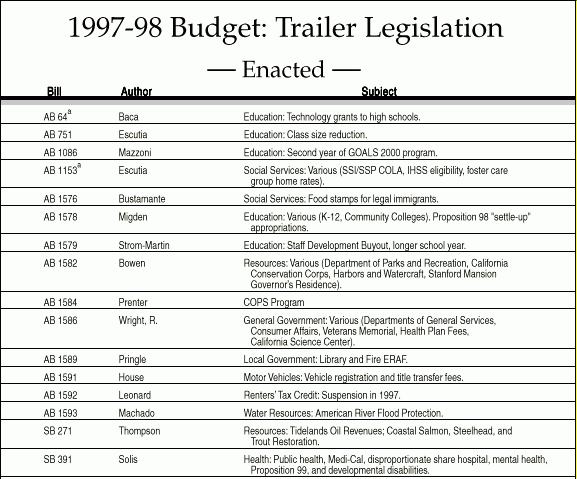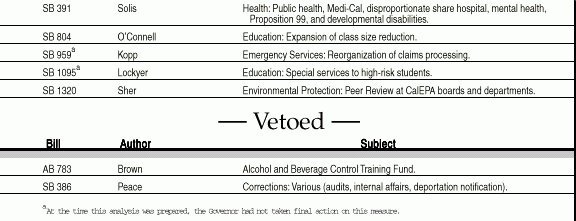
 |
Major Features of |
On August 18, 1997 the Governor signed the 1997 Budget Act. In this report we highlight the major features of the budget package.
V. Judiciary and Criminal Justice
Appendix 1: Trailer Legislation
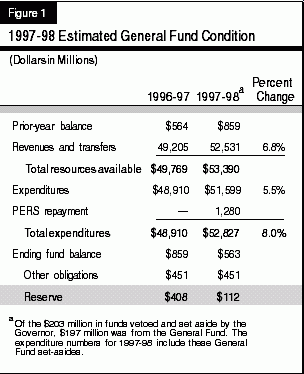
Before signing the budget, the Governor used his line-item veto authority to delete $314 million in appropriations adopted by the Legislature. The Governor indicated that about $203 million of these cuts were temporary, in that they could be restored later upon enactment of legislation which meets his requirements involving a mandatory educational testing program for all California pupils in grades 2 through 11. The expenditure totals in Figure 1 assume restoration of these $203 million of temporary cuts. If not restored, these funds would nevertheless be set aside for Proposition 98 purposes.
The 1997-98 Budget Act includes significant increases in education spending and a major reform to the state's welfare program. In other areas, the budget includes relatively few new initiatives and fairly limited changes to program funding. This is due mainly to the decision to repay a substantial deferred obligation to the Public Employees' Retirement System (PERS) in 1997-98.
The PERS Repayment—$1.2 Billion. In late May, the California Supreme Court refused to hear an appeal of lower court rulings which had declared unconstitutional the General Fund's deferral of state contributions to the retirement fund in the early 1990s. As a result, the state was ordered to repay $1.2 billion in principal, plus interest.
Following the Supreme Court's PERS decision, it became clear that it would be difficult to fund various legislative and executive augmentations and make the PERS repayment unless it could be spread over several years. After several weeks of negotiations failed to produce agreements, the Governor directed that the full $1.2 billion principal amount be immediately transferred to PERS.
The PERS repayment removed virtually all of the discretionary funds that had been available in the non-Proposition 98 portion of the budget and effectively required the Budget Conference Committee to eliminate most of the spending augmentations considered in the budget. As a result, the non-Proposition 98 portion of the budget is relatively tight, containing limited augmentations.
K-12 Education. Healthy revenue growth, coupled with other factors affecting Proposition 98 spending, led to major increases in K-14 education funding in both 1996-97 and 1997-98. The budget uses these gains to expand the class size reduction program to a fourth grade and significantly increases local revenue limit funding.
Higher Education. The budget includes significant funding increases for the University of California, California State University, and California Community Colleges, with no student fee increases.
Welfare Reform. The budget funds a major welfare reform program—CalWORKs (California Work Opportunity and Responsibility to Kids Program). It includes time limits on aid for adults, participation requirements for adults, expanded child care and job training services, and various county fiscal incentives.
Other Health and Welfare Provisions. The budget rejects the Governor's proposal to make permanent the 4.9 percent Supplemental Security Income/State Supplementary Program (SSI/SSP) statewide grant reduction, and instead restores the grant on November 1, 1997. The budget extends the previously enacted 4.9 percent Aid to Families with Dependent Children (AFDC) grant reduction through October 1998, and suspends both AFDC and SSI/SSP cost-of-living adjustments for an additional year.
Regarding Medi-Cal, the budget funds prenatal services for illegal immigrants until October 1, 1997. The Governor vetoed budget language to continue the program.
Corrections. The budget essentially funds inmate caseload, contains no money for new prisons and provides few new initiatives. In addition, the budget assumes $94 million more in federal funds than the amount included in the Governor's budget to offset the state's costs of supervising undocumented felons.
Local Government. The budget continues the Citizen's Option for Public Safety program ($100 million). It also reduces the state's "take-out" from the disproportionate share hospital payments, thereby increasing county resources by $75 million. Following the PERS repayment, the Legislature eliminated the shift of property taxes from the state back to local governments (proposed at $100 million by the Governor and at $280 million by the Assembly). It also eliminated $50 million that had been proposed by the Governor to capitalize the infrastructure bank.
Other Programs. The budget extends the suspension of the renters' tax credit for one additional year (the Governor had proposed permanent elimination of the credit). The budget contains no general employee salary increase.
Veto Set Asides. About $203 million of the vetoes are funds which have been "set aside"
by the Governor for restoration upon enactment of legislation which satisfies his requirements
for a mandatory testing program in
K-12 education. Of the set-asides, about $197 million is Proposition 98 General
Fund monies, with the remainder for non-Proposition 98 General Fund, special funds
and federal funds.
Other Vetoes. The majority of the remaining vetoes are in health and welfare and community colleges.
Prepared by the Economics and Fiscal Forecasting Section—(916) 324-4942
Figure 1 describes the major General Fund changes enacted in the 1997-98 Budget Act and related legislation.
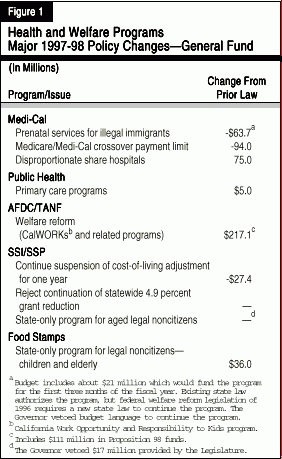
The budget, as passed by the Legislature, also expressed intent to reduce the state "takeout" by an additional $25 million in 1998-99. This language was subsequently vetoed by the Governor.
The budget action primarily benefits counties that operate county hospitals, which provide most of the DSH transfers. Absent the budget action, these counties would have to increase their DSH contributions by about $50 million to offset the loss of contributions from Fresno and several smaller counties that recently closed their county hospitals. The remaining benefit of about $25 million will enable counties to reduce their contributions or to receive more DSH funds.
Medicare/Medi-Cal "Crossover" Payment Limits. The recently enacted federal budget legislation allows California to reinstate crossover payment limits, for an estimated General Fund savings of $94 million in 1997-98, assuming implementation by September 1, 1997. These payment limits apply to dual beneficiaries—persons who qualify for benefits under both the Medi-Cal Program and the federal Medicare Program.
Currently, allowable Medicare charges for a service often exceed Medi-Cal rates. Under the crossover limits, however, Medi-Cal will only pay deductibles and copayments for Medicare covered services to the extent necessary to meet the Medi-Cal payment rate, and Medicare providers must accept the Medi-Cal rates as payment in full. The federal courts overturned California's existing crossover limits in 1996. The federal budget legislation enables the state to reinstate the limits.
Continuation of Prenatal Care for Illegal Immigrant Women. The budget bill, as passed by the Legislature, authorized the continuation of prenatal benefits for illegal immigrants and provided $23 million to partially fund those costs in 1997-98. The Governor vetoed the language authorizing the program and reduced the funding by $1.7 million. Consequently, this leaves $21 million for the program which he indicated would terminate October 1, 1997.
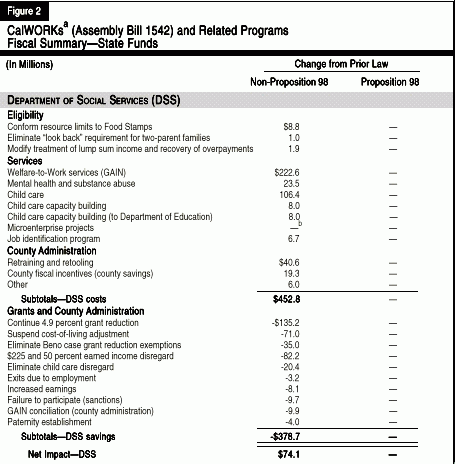
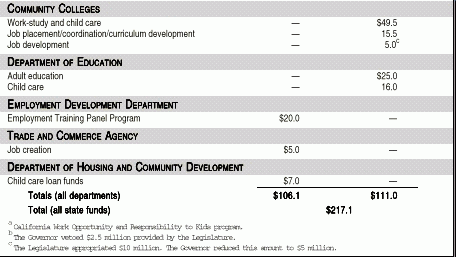
|
Figure 3
CalWORKsa (Assembly Bill 1542) Major Features |
Eligibility
|
Grants
|
Services
|
Participation Requirements
|
Time Limits
|
County Administration
|
|
a California Work Opportunity and Responsibility to Kids program.
b Temporary Assistance for Needy Families. |
Elderly Noncitizens. Federal welfare reform, as amended by the Balanced Budget Act of 1997, makes elderly legal noncitizens, who were in the United States prior to August 22, 1996 but not yet receiving aid, ineligible for the Supplemental Security Income/State Supplementary Program. The budget, as passed by the Legislature, provided state-only funded benefits for such legal noncitizens, resulting in a General Fund cost of $17 million in 1997-98. Subsequently, the Governor vetoed these funds.
Prepared by the Health and Social Services Section—(916) 445-6061
In this section, we describe the major features of the budget package as it relates to the Proposition 98 minimum funding guarantee and K-12 schools.
The K-12 portion of the Proposition 98 budget package includes:
Figure 1 summarizes for 1996-97 and 1997-98 the effect of the budget package on K-12 schools, community colleges, and other specified agencies. Proposition 98 funding for K-12 schools totals $28.7 million in 1997-98.
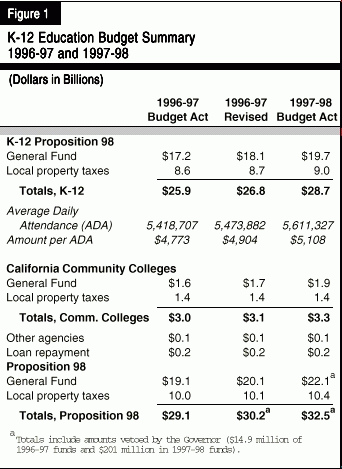
1996-97 and Prior Years Settle-Up Funding. Proposition 98 minimum funding levels are determined by one of four specified formulas, each using a set of specified fac-tors. Because the factors change during the year, the minimum funding guarantee under Proposition 98 also changes. Any additional amount needed to satisfy the guarantee is referred to as Proposition 98 "settle-up" funding.
The budget contains approximately $1.4 billion in settle-up funds. Figure 2 displays the major allocations of these monies. Pursuant to Chapter 203, Statutes of 1996 (AB 3497, Richter) the budget provides $522 million for revenue limit equalization and deficit reduction, with half the funds going to each purpose. The remaining funds are allocated for a variety of one-time purposes. For example, $159 million of the funds are allocated for facilities for class size reduction. These funds will pay for facilities requested for the 1996-97 school year that were not previously funded. The budget also provides one-time funds for deferred maintenance, educational technology (digital high school), and creation of new child care facilities.
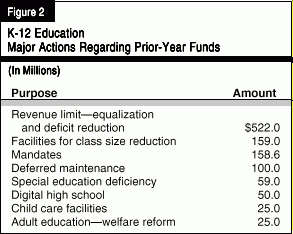
1997-98 Baseline Increases. Compared to the 1996-97 Budget Act, K-12 Proposition 98
funding increased by $3 billion in 1997-98. Figure 3 displays the major K-12
Proposition 98 appropriations for 1997-98. The budget allocates $1.4 billion to
provide inflation and growth adjustments. Specifically, the budget includes about
$722 million to accommodate a projected 2.5 percent increase in the student
population and $707 million for a cost-of-living adjustment (2.65 percent) for
K-12 programs. As Figure 3 also indicates, $143 million in categorical program
growth and inflation adjustments were vetoed pending the resolution of the assessment issues.
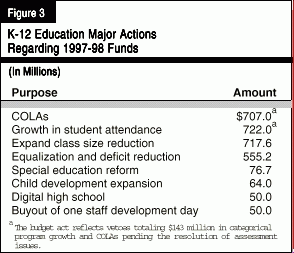
The budget directs the remaining $1.6 billion for other purposes, including new programs and existing K-12 categorical programs. The major discretionary increases approved in the budget are as follows:
Governor's Vetoes. As noted in Figure 1, the Governor vetoed $14.9 million of "settle-up" funds and $201 million in 1997-98 Proposition 98 funds. While the Governor typically uses his veto authority to delete specific appropriations, most of the vetoed Proposition 98 funds have been "set aside" pending the resolution of K-12 assessment issues. These issues revolve around the Governor's proposal to eliminate the existing voluntary student assessment program and create a new mandatory program.
In his veto messages, the Governor identifies the vetoed funds that are included in the set-aside. The Governor includes $10.2 million of the $14.9 million vetoed settle-up funds and $186 million of the $201 million vetoed 1997-98 Proposition 98 funds in his set-aside. The $10.2 million in settle-up funds were appropriated for 14 new programs, many affecting only one school district. Of the $186 million in 1997-98 funds set aside by the Governor, $143 million were for K-12 categorical program growth and COLA funding and $30 million for the mandatory testing program. An additional $2.5 million in K-12 augmentations were set-aside (as well as $4 million in federal Goals 2000 funds). The Governor also set aside $10.6 million in community college Proposition 98 funds.
Prepared by the Education Section—(916) 445-8641

The 1997-98 Budget Act, as signed by the Governor, provides $121 million (5.9 percent) more in General Fund support for the University of California (UC) in 1997-98 compared to 1996-97. The budget assumes no general increase in undergraduate and graduate student fees, although growth in the number of UC students and the fourth year of a four-year planned increase in graduate professional program fees (including law, medicine, dentistry, and veterinary medicine) will generate an expected $10.8 million in revenues for the UC in 1997-98.
The Legislature approved a budget plan for the UC that includes:
The 1997-98 Budget Act, as signed by the Governor, provides $108 million (6.1 percent) more in General Fund support for the California State University (CSU) in 1997-98 than in 1996-97. As with the UC, the budget assumes no general increase in student fees.
The Legislature approved a budget plan for the CSU that includes:
Because of the major increases in Proposition 98 funding in 1996-97 and 1997-98, the 1997 budget package contains major funding increases for community colleges. Specifically, General Fund spending for community colleges totals almost $1.9 billion in the budget year. This represents a $287 million, or 18 percent, increase above the funding level included in the 1996-97 Budget Act. (The 1996-97 total implicit in Figure 1 does not include $106 million of one-time funds made available to the colleges due to the recent upward revision of the Proposition 98 guarantee for that fiscal year.) The budget does not contain any increase in student fee levels. Fee revenues, however, will increase due to enrollment growth.
1997-98 Expenditures. Figure 2 illustrates the major program increases provided with the additional funds in 1997-98. The budget includes $89 million for colleges to increase enrollment by a statewide average of 3 percent. The budget also provides $65 million for various services for students on welfare, expands the economic development program (by $15 million), and starts a job development program ($5 million).
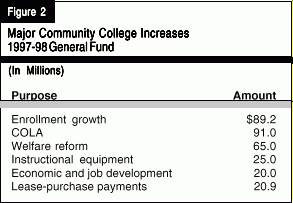
Settle-Up Expenditures. The budget includes $130 million in settle-up funding for 1996-97 and prior years for several one-time activities. Of this amount, the budget allocates $98 million for district block grants, which will be allocated on a per-student basis. The budget also provides $20 million for deferred maintenance and $10 million for child care facilities.
Vetoes. The Governor vetoed $24 million of 1997-98 appropriations for the community colleges. In his veto message, the Governor expressed his willingness to restore $10.6 million of this amount—$8.6 million for equalization and $2 million for office hours for part-time faculty—upon enactment of legislation meeting his criteria for statewide testing of pupils in grades 2 through 11. The remaining vetoes included a $5 million reduction for faculty and staff development and a $5 million reduction in a new job development program.
The budget appropriates $295 million from the General Fund for the Student Aid Commission in 1997-98, which is an increase of $31 million, or 11.5 percent. Of this amount, $26 million represents augmentations to the Cal-Grant program, which provides financial aid grants to higher education students in California. These augmentations include funds to increase the number of grants by 3,916 students and to increase the maximum grant amount for students attending private colleges and universities from $7,164 to $8,184.
Prepared by the Education Section—(916) 445-8641
V. Judiciary and Criminal Justice
The 1997-98 budget for judicial and criminal justice programs totals $5.4 billion,
including $4.7 billion from the General Fund and $663 million from state special
funds. This is an increase of $308 million, or 6.1 percent, over 1996-97
expenditures. This increase is due to a number of factors, including increases in spending to
accommodate the projected growth in the state's prison and parole populations, declining federal
support (and thus increased state costs) to pay the costs of incarcerating undocumented felons in
state prison, and increases in state support of the trial courts financed primarily by increases in
court filing fees.
The amount is about $266 million below the Governor's proposed budget. The principal reasons for the change are legislative actions to use additional federal funds to pay the costs of incarcerating undocumented felons, downward revisions of estimates of the prison inmate population, and the Legislature's rejection of some policy initiatives and augmentations proposed by the Governor.
In January, the Governor proposed a major consolidation of funding responsibility for the trial courts at the state level. Under the proposal, the largest counties would pay for a capped portion of the costs of the courts (roughly equivalent to the amount they paid in 1994-95) and the state would provide all additional funding. Also, the state would pay for all costs of the 20 smallest counties. The Governor also proposed increases in trial court civil filing fees of $88 million to help finance the state's additional costs.
In enacting the 1997-98 Budget Act, the Legislature modified the Governor's plan substantially. Among the changes, the Legislature capped the contributions for all counties and, beginning in 1998-99, provided that the state will pay all costs for the 20 smallest counties. In addition, the Legislature provided that beginning in 1998-99, the state would take over a larger share of costs for the trial courts than proposed by the Governor. The budget also assumes enactment of the Governor's proposal to increase civil filing fees. The changes to accomplish the Legislature's actions are included in AB 233 (Escutia), which is still under consideration.
The Governor also proposed a number of policy initiatives related to the trial courts, including several statewide jury system improvements ($14 million), enhancements for trial court security systems ($8 million), and 40 new judgeships to be established in the last quarter of 1997-98 ($4 million). These proposals were rejected by the Legislature.
The budget reflects a total General Fund reduction of about $90.1 million below the Governor's budget request for the CDC support budget. The most significant changes were a $31 million unallocated reduction to departmental programs, a $20.7 million reduction to reflect recent caseload trends, and a $16.2 million shift of bond payments from the General Fund to bond funds no longer needed for prison construction.
The 1997-98 Budget Act includes no funds for planning or construction of new prison facilities. However, the bill sent to the Governor did include $2.5 million to expand drug treatment for inmates and other provisions intended to help slow future growth in the prison population.
In addition, the budget provides $54.6 million in federal prison construction funds to the Board of Corrections for allocation to local governments to construct, expand, or modify local adult and juvenile detention facilities. The Governor had proposed $14.9 million for this purpose in his January budget. The 1997-98 Budget Act provides that at least $20 million of the amount appropriated be used to build new or modify existing juvenile detention facilities in counties with populations of 200,000 or less.
Initiatives and Augmentations. The Governor proposed a number of program initiatives, including a $20 million program for "at-risk" juveniles and a $15 million Community Law Enforcement And Recovery (CLEAR) Demonstration Project, that were not included in the enacted budget. Similarly, the Legislature considered a number of initiatives and augmentations, such as expansion of the Juvenile Crime Enforcement and Accountability Challenge Grant Program. Almost all of these initiatives and augmentations were ultimately rejected as well.
Restitution Fund Loan. The budget includes a loan of $26 million of surplus funds from the Restitution Fund, which supports the Board of Control's Victims of Crime Program, to the General Fund. The budget act provides that the funds be repaid to the Restitution Fund by June 30, 1999.
Prepared by the Criminal Justice Section—(916) 445-4660
The 1997 budget provides $804 million for environmental protection programs, including about $680 million for state environmental protection agencies and $124 million for local assistance. Significant features include:
The budget also provides $1.9 billion for transportation capital outlay projects. This amount includes $157 million to restore damage caused by heavy storms in December 1996 and January 1997.
The budget provides $1.3 billion for a variety of local assistance programs, primarily a pass-through of federal funds for highway and transit purposes and state funds for the State-Local Transportation Partnership Program. This amount also includes $32 million in federal funds to repair storm damage on local streets and roads. Local assistance to transit authorities includes $85 million for operating assistance (through the State Transit Assistance program) and $64 million for capital acquisition (through the Transit Capital Improvement program).
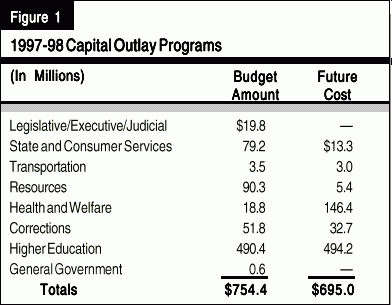
Some of the major projects and programs funded in
1997-98 include:
Prepared by the following sections:
Appendix I: Trailer Legislation
